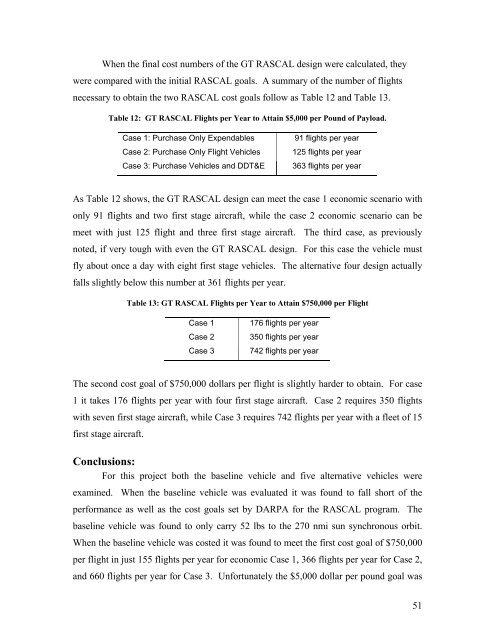Responsive Access Small Cargo Affordable Launch (RASCAL ...
Responsive Access Small Cargo Affordable Launch (RASCAL ...
Responsive Access Small Cargo Affordable Launch (RASCAL ...
You also want an ePaper? Increase the reach of your titles
YUMPU automatically turns print PDFs into web optimized ePapers that Google loves.
When the final cost numbers of the GT <strong>RASCAL</strong> design were calculated, they<br />
were compared with the initial <strong>RASCAL</strong> goals. A summary of the number of flights<br />
necessary to obtain the two <strong>RASCAL</strong> cost goals follow as Table 12 and Table 13.<br />
Table 12: GT <strong>RASCAL</strong> Flights per Year to Attain $5,000 per Pound of Payload.<br />
Case 1: Purchase Only Expendables 91 flights per year<br />
Case 2: Purchase Only Flight Vehicles 125 flights per year<br />
Case 3: Purchase Vehicles and DDT&E 363 flights per year<br />
As Table 12 shows, the GT <strong>RASCAL</strong> design can meet the case 1 economic scenario with<br />
only 91 flights and two first stage aircraft, while the case 2 economic scenario can be<br />
meet with just 125 flight and three first stage aircraft. The third case, as previously<br />
noted, if very tough with even the GT <strong>RASCAL</strong> design. For this case the vehicle must<br />
fly about once a day with eight first stage vehicles. The alternative four design actually<br />
falls slightly below this number at 361 flights per year.<br />
Table 13: GT <strong>RASCAL</strong> Flights per Year to Attain $750,000 per Flight<br />
Case 1 176 flights per year<br />
Case 2 350 flights per year<br />
Case 3 742 flights per year<br />
The second cost goal of $750,000 dollars per flight is slightly harder to obtain. For case<br />
1 it takes 176 flights per year with four first stage aircraft. Case 2 requires 350 flights<br />
with seven first stage aircraft, while Case 3 requires 742 flights per year with a fleet of 15<br />
first stage aircraft.<br />
Conclusions:<br />
For this project both the baseline vehicle and five alternative vehicles were<br />
examined. When the baseline vehicle was evaluated it was found to fall short of the<br />
performance as well as the cost goals set by DARPA for the <strong>RASCAL</strong> program. The<br />
baseline vehicle was found to only carry 52 lbs to the 270 nmi sun synchronous orbit.<br />
When the baseline vehicle was costed it was found to meet the first cost goal of $750,000<br />
per flight in just 155 flights per year for economic Case 1, 366 flights per year for Case 2,<br />
and 660 flights per year for Case 3. Unfortunately the $5,000 dollar per pound goal was<br />
51

















